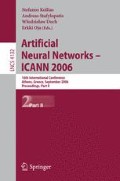Abstract
In the development of location-based services, various location-sensing techniques and experimental/commercial services have been used. We propose a novel method of predicting the user’s future movements in order to develop advanced location-based services. The user’s movement trajectory is modeled using a combination of recurrent self-organizing maps (RSOM) and the Markov model. Future movement is predicted based on past movement trajectories. To verify the proposed method, a GPS dataset was collected on the Yonsei University campus. The results were promising enough to confirm that the application works flexibly even in ambiguous situations.
Access this chapter
Tax calculation will be finalised at checkout
Purchases are for personal use only
Preview
Unable to display preview. Download preview PDF.
References
Ashbrook, D., Starner, T.: Learning Significant Locations and Predicting User Movement with GPS. In: Proceedings of IEEE Sixth International Symposium on Wearable Computing, Seattle, WA (October 2002)
Stilp, L.: Carrier and End-User Applications for Wireless Location Systems. In: Proceedings of SPIE, vol. 2602, pp. 119–126 (1996)
Pousman, Z., Iachello, G., Fithian, R., Moghazy, J., Stasko, J.: Design Iterations for a Location-Aware Event Planner. Personal and Ubiquitous Computing 8(2), 117–225 (2004)
Benford, S., Anastasi, R., Flintham, M., Drozd, A., Crabtree, A., Greenhalgh, C., Tandavanitj, N., Adams, M., Row-Farr, J.: Coping with uncertainty in a location-based game. IEEE Pervasive Computing 2(3), 34–41 (2003)
Cheok, A.D., Goh, K.H., Liu, W., Farbiz, F., Fong, S.W., Teo, S.L., Li, Y., Yang, X.: Human Pacman: A Mobile, Wide-area Entertainment System based on Physical, Social, and Ubiquitous Computing. Personal and Ubiquitous Computing 8(2), 71–81 (2004)
Ashbrook, D., Starner, T.: Using GPS to Learn Significant Locations and Predict Movement Across Multiple Users. Personal and Ubiquitous Computing 7(5), 275–286 (2003)
Patterson, D., Liao, L., Fox, D., Kautz, H.: Inferring High-Level Behavior from Low- Level Sensors. In: Proceedings of the Fifth International Conference on Ubiquitous Computing, Seattle, WA, October 2003, pp. 73–89 (2003)
Sparacino, F.: Sto(ry)chastics: A Bayesian Network Architecture for User Modeling and Computational Storytelling for Interactive Spaces. In: Proceedings of the Fifth International Conference on Ubiquitous Computing, Seattle, WA, October 2003, pp. 54–72 (2003)
Haykin, S.: Neural Networks: A Comprehensive Foundation, 2nd edn. Prentice Hall, Englewood Cliffs (1999)
Koskela, T., Varsta, M., Heikkonen, J., Kaski, K.: Temporal Sequence Processing using Recurrent SOM. In: Proceedings of Second International Conference on Knowledge- Based Intelligent Engineering Systems, Adelaide, Australia, April 1998, vol. 1, pp. 290–297 (1998)
Winston, W.L.: Operations Research: Applications and Algorithms. Duxbury, Belmont (1994)
Author information
Authors and Affiliations
Editor information
Editors and Affiliations
Rights and permissions
Copyright information
© 2006 Springer-Verlag Berlin Heidelberg
About this paper
Cite this paper
Han, SJ., Cho, SB. (2006). Predicting User’s Movement with a Combination of Self-Organizing Map and Markov Model. In: Kollias, S., Stafylopatis, A., Duch, W., Oja, E. (eds) Artificial Neural Networks – ICANN 2006. ICANN 2006. Lecture Notes in Computer Science, vol 4132. Springer, Berlin, Heidelberg. https://doi.org/10.1007/11840930_92
Download citation
DOI: https://doi.org/10.1007/11840930_92
Publisher Name: Springer, Berlin, Heidelberg
Print ISBN: 978-3-540-38871-5
Online ISBN: 978-3-540-38873-9
eBook Packages: Computer ScienceComputer Science (R0)

